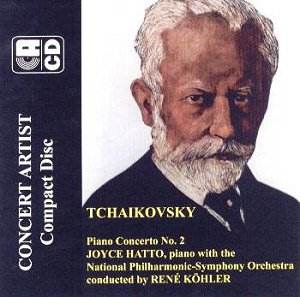This disc is what I’d call Moiseiwitsch territory.
He recorded both these concertos – available now on APR (Tchaikovsky)
and Naxos (Saint-Saëns) – though whilst the Tchaikovsky was the
first European recording it was also very heavily cut, the perhaps-expected
Siloti excisions being exacerbated by the pianist’s own. Which made
it, I suppose, a recording of a substantial torso at least. Joyce Hatto
of course plays it complete.
The joy of the Saint-Saëns never pales in a performance
that is strong on fantasy and playful drive. The opening Bachian Fantasia
is despatched with anticipatory clarity – comparison with the Moiseiwitsch
recording shows a similarly compelling colouristic and actively imaginative
response – and the following introspective passages are extremely well
nuanced. In the second movement she has a keen ear for dynamics, plenty
of rhythmic wit and real insouciance, with cascading runs, treble glitter,
though never at so fleet a tempo as to gabble the syntax. When it comes
to the finale there is bustling character in profusion and if the orchestra
is a little distant - and the sound as recorded in St Marks Church,
Croydon, can tend toward the brash – there is still no want of style
and vigour as Hatto drives her way to the conclusion.
The companion Concerto, Tchaikovsky’s Second, can take
on the character, in the second movement, of a triple concerto with
its solo violin and cello parts. It’s a big work here lasting forty-four
minutes. Arguably the success or otherwise of the first movement depends
on a balance between introspection and animation. There are some pleasing
orchestral contributions here from members of the National Philharmonic-Symphony
Orchestra (as before in this orchestral series I don’t know who they
are but the clarinet and horn soloists are especially distinctive).
And there is real visceral bravura in Joyce Hatto’s cadenza – she can
be an incendiary artist and holds nothing back when it’s demanded of
her. The augmented chamber intimacies of the Andante non troppo are
graced by violinist Mark Manning and cellist Adrian Creighton. They
are both chaste and affectionate – contrast Nigel Kennedy and Steven
Isserlis in the Peter Donohoe/Bournemouth/Barshai recording who are
rather more assertive and tonally effulgent – but the movement seems
to generate its own internal momentum in this performance; in short,
it unfolds, which must be largely the work of conductor René
Köhler. The peak of lyrical effusion is reached at 12.40 in this
performance after which the ominous percussion and brass fail to derail
the piano’s levelheaded and determined progress. The finale, by far
the shortest movement, is by contrast full of fire and driving warm-heartedness.
Maybe the octave conclusion lacks the sheer verve and incinerating drive
of Donohoe but Hatto is still commanding enough on her own terms. It’s
a splendidly convincing traversal.
This is a fine brace of recordings, the bracketing
of which reinforce Joyce Hatto’s romantic affiliations and her place
in the historical continuum. Wise, adept, lyrical but technically imposing
she still has much to teach.
Jonathan Woolf
see also
JOYCE
HATTO -
A Pianist of Extraordinary Personality and Promise:
Comment and Interview by Burnett James
MusicWeb
can offer the complete Concert
Artist catalogue
